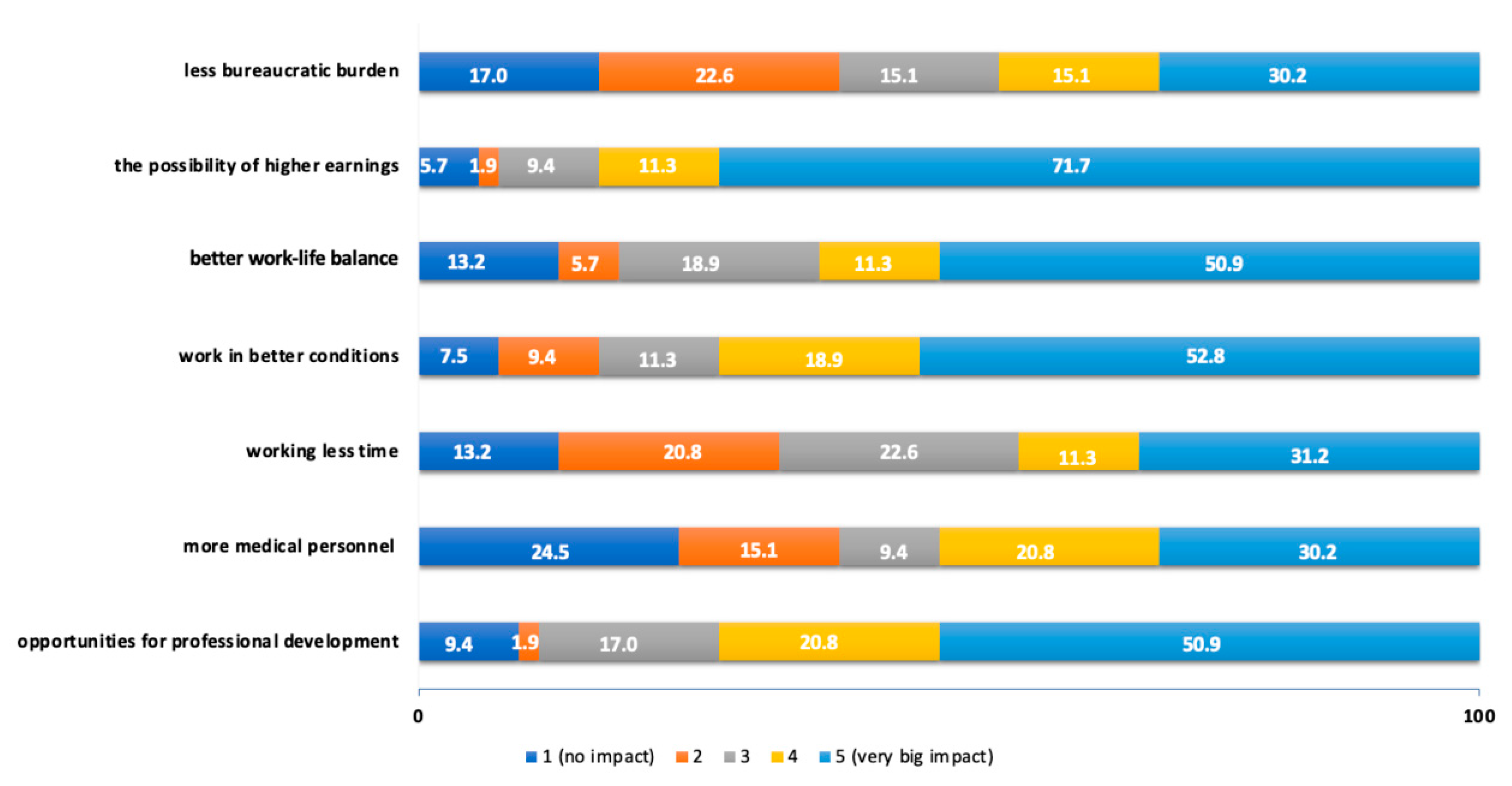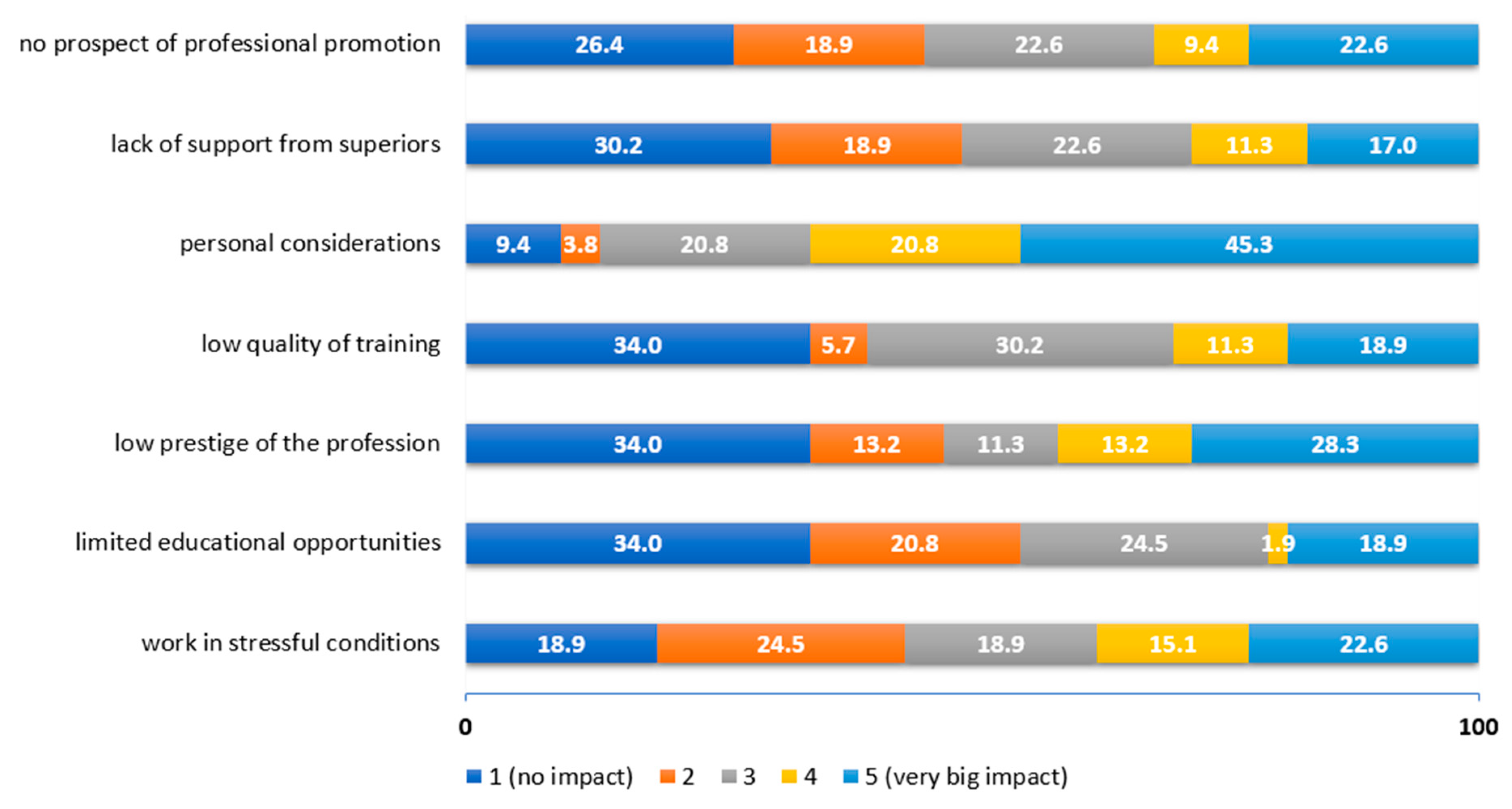Factors Affecting Migration Intentions of Polish Physiotherapists and Students of Physiotherapy—A Cross-Sectional Study
Abstract
1. Introduction
2. Materials and Methods
2.1. Data Collection
2.2. Study Participants
2.3. Ethical Procedures
2.4. Study Design
2.5. Statistical Analysis
3. Results
3.1. Migration Plans
3.2. Migration Factors
3.3. Destination Countries for Migration
3.4. Barriers to Emigration
4. Discussion
4.1. Implications of the Study and Recommendations for Further Research
4.2. Strengths and Limitations
5. Conclusions
Supplementary Materials
Author Contributions
Funding
Institutional Review Board Statement
Informed Consent Statement
Data Availability Statement
Acknowledgments
Conflicts of Interest
References
- Aluttis, C.; Bishaw, T.; Frank, M.W. The workforce for health in a globalized context-global shortages and international migration. Glob. Health Action 2014, 7, 23611. [Google Scholar] [CrossRef] [PubMed]
- World Migration Report 2020. International Organization for Migration. 2022. Available online: https://publications.iom.int/system/files/pdf/wmr_2020.pdf (accessed on 28 October 2022).
- Scheil-Adlung, X.; Nove, A. Global estimates of the size of the health workforce contributing to the health economy: The potential for creating decent work in achieving universal health coverage. In Health Employment and Economic Growth: An Evidence Base; Buchan, J., Dhillon, I., Campbell, J., Eds.; World Health Organization: Geneva, Switzerland, 2016; pp. 139–172. [Google Scholar]
- Ferreira, P.L.; Raposo, V.; Tavares, A.I.; Correia, T. Drivers for emigration among healthcare professionals: Testing an analytical model in a primary healthcare setting. Health Policy 2020, 124, 751–757. [Google Scholar] [CrossRef] [PubMed]
- Buchan, J.; Wismar, M.; Glinos, I.A.; Bremmer, J. Health professional mobility in a changing Europe. In New Dynamics, Mobile Individuals and Diverse Response; WHO: Copenhagen, Denmark, 2014. [Google Scholar]
- Wismar, M.; Maier, C.B.; Glinos, I.A.; Dussault, G.; Figueras, J. Health Professional Mobility and Health Systems: Evidence from 17 European Countries; Observatory Studies; WHO Regional Office for Europe on behalf of the European Observatory on Health Systems and Policies: Copenhagen, Denmark, 2011. [Google Scholar]
- Glinos, I. Health professional mobility in the European Union: Exploring the ethics and efficiency of free movement. Health Policy 2015, 119, 1526–1536. [Google Scholar] [CrossRef] [PubMed]
- WHO: The WHO Global Code of Practice on the International Recruitment of Health Personnel. Available online: https://www.who.int/hrh/migration/code/WHO_global_code_of_practice_EN.pdf (accessed on 10 August 2022).
- Dussault, G.; Fronteira, I.; Cabral, J. Migration of health personnel in the WHO European Region. 2009. Available online: www.euro.who.int/__data/assets/pdf_file/0010/95689/E93039.pdf (accessed on 10 August 2022).
- Bludau, H. Global Healthcare Worker Migration. Oxf. Res. Encycl. Anthropol. 2021. [Google Scholar] [CrossRef]
- The Polish Supreme Audit Office (NIK). Kształcenie i Przygotowanie Zawodowe Kadr Medycznych. Report Dedicated to Training of Medical Staff. 2016. Available online: www.nik.gov.pl/plik/id,10242,vp,12565.pdf (accessed on 10 August 2022).
- Domagała, A.; Kautsch, M.; Kulbat, A.; Parzonka, K. Exploration of Estimated Emigration Trends of Polish Health Professionals. Int. J. Environ. Res. Public Health 2022, 19, 940. [Google Scholar] [CrossRef] [PubMed]
- European Union’s Directive. 2005/36/ec of the European Parliament and of the Council of 7 September 2005 on the Recognition of Professional Qualifications. Available online: http://eur-lex.europa.eu/legal-content/EN/TXT/?qid=1401715075231&uri=CELEX%3A32005L0036 (accessed on 4 September 2022).
- Kubitsky, J. Psychologia Migracji; Difin SA: Warszawa, Poland, 2012. [Google Scholar]
- Cahalin, L.P.; Matsuo, Y.; Collins, S.M.; Matsuya, A.; Caro, F. Educational and professional issues in physical therapy—An international study. Physiother. Theory Pract. 2008, 5, 344–359. [Google Scholar] [CrossRef] [PubMed]
- Foo, J.S.; Storr, M.; Maloney, S. Registration factors that limit international mobility of people holding physiotherapy qualifications: A systematic review. Health Policy 2016, 120, 665–673. [Google Scholar] [CrossRef] [PubMed]
- Mapy Potrzeb Zdrowotnych. Available online: https://basiw.mz.gov.pl/index.html#/visualization?id=3403 (accessed on 28 August 2022).
- Woźnica, D.; Śmigielski, W.; Koper, A.; Krawczyk, M.; Niewiadomski, T.; Adamkiewicz, P.; Koszela, J. Territorial differentiation in the physiotherapy profession in Poland. Physiother. Rev. 2021, 25, 52–61. [Google Scholar] [CrossRef]
- Polish Chamber of Physiotherapists. Krajowa Izba Fizjoterapeutów. Wyniki Badania Polski Fizjoterapeuta. Available online: www.kif.info.pl/wyniki-badania-polski-fizjoterapeuta (accessed on 28 August 2022).
- Act on Profession of Physioterapists, Ustawa z Dnia 25 Września 2015 r. o Zawodzie Fizjoterapeuty, 2015 Dz. U. 2015 Poz. 1994. Available online: https://isap.sejm.gov.pl/isap.nsf/DocDetails.xsp?id=WDU20150001994 (accessed on 28 August 2022).
- Ministerstwo Rodziny i Polityki Społecznej. Barometr zawodów. 2022. Available online: https://barometrzawodow.pl (accessed on 4 September 2022).
- European Commission. The EU single market. In Regulated Profession Database; European Commission: Brussels, Belgium; Available online: https://ec.europa.eu/growth/tools-databases/regprof (accessed on 20 August 2022).
- Polish Chamber of Physiotherapists. Krajowa Izba Fizjoterapeutów—Data on the Number of Issued Certificates Confirming the Professional Qualifications of Physiotherapists (Email Communications between authors and KIF; 12 September 2022).
- Uchwala nr 2/2020 Zgromadzenia Ogólnego Polskiej Akademii Nauk z Dnia 25 Czerwca 2020 r. w Sprawie Kodeksu Etyki Pracownika Naukowego. Available online: Sip.lex.pl/akty-prawne/akty-korporacyjne/kodeks-etyki-pracownika-naukowego-287453395 (accessed on 25 August 2022).
- World Medical Association. World Medical Association Declaration of Helsinki: Ethical principles for medical research involving human subjects. JAMA 2013, 310, 2191–2194. [Google Scholar] [CrossRef] [PubMed]
- Szczepańska, B.; Szady-Grad, M.; Klawe, J.; Kołodziejska, K.; Złotowska, A. Plany zawodowe studentów fizjoterapii i ratownictwa medycznego Collegium Medicum w Bydgoszczy. Probl. Hig. I Epidemiol. 2010, 91, 704–707. [Google Scholar]
- Szostek, Ł.; Leńczuk-Gruba, A.; Kobos, E.; Imiela, J. Nursing students’ professional plans regarding migration. Pol. Nurs. 2017, 3, 481–486. [Google Scholar]
- Dubas-Jakóbczyk, K.; Domagała, A.; Kiedik, D.; Peña-Sánchez, J.N. Exploring Satisfaction and Migration Intentions of Physicians in Three University Hospitals in Poland. Int. J. Environ. Res. Public Health 2020, 17, 43. [Google Scholar] [CrossRef] [PubMed]
- Jabłońska, P.I.; Duda, A.; Mrowca, C. Wybrane aspekty emigracji wśród personelu pielęgniarskiego. Pielęgniarstwo I Zdr. Publiczne 2016, 6, 15–21. [Google Scholar]
- Szpakowski, R.; Dykowska, G.; Fronczak, A.; Zając, P.; Czerw, A. Migrations of nurses and doctors from Poland: Data for the years 2014–2020 based on the sample of the capital city of Warsaw. Arch. Med. Sci. 2019, 15, 811–820. [Google Scholar] [CrossRef] [PubMed]
- OECD. Recent Trends in International Migration of Doctors, Nurses and Medical Students; OECD Publishing: Paris, France, 2019. [Google Scholar]
- Merçay, C.; Dumont, J.C.; Lafortune, G. Trends and policies affecting the international migration of doctors and nurses to OECD countries. In Health Workforce Policies in OECD Countries: Right Jobs, Right Kills, Right Places; OECD Health Policy Studies; OECD Publishing: Paris, France, 2016; pp. 103–124. [Google Scholar]
- Filippidis, F.T. Emigrating young physicians leave Greece with an aging health workforce. J. Public Health 2015, 38, e587. [Google Scholar] [CrossRef] [PubMed][Green Version]
- Madarac, S.M. The research of students attitudes towards migration after graduation. In Proceedings of the 27th International Scientific Conference on Economic and Social Development, Rome, Italy, 1–2 March 2018. [Google Scholar]
- Pónusz, R.; Kovács, D.; Varga, A.; Hock, M.; Raposa, B.; Boncz, I.; Endrei, D. Survey of the Hungarian Physiotherapists’ Migration and Career Changing Behaviour. Value Health 2015, 18, A555. [Google Scholar] [CrossRef][Green Version]
- Krajewski-Siuda, K.; Szromek, A.; Romaniuk, P.; Gericke, C.A.; Szpak, A.; Kaczmarek, K. Emigration preferences and plans among medical students in Poland. Hum. Resour. Health 2012, 10, 8. [Google Scholar] [CrossRef] [PubMed]
- Suciu, Ş.M.; Popescu, C.A.; Ciumageanu, M.D.; Buzoianu, A.D. Physician migration at its roots: A study on the emigration preferences and plans among medical students in Romania. Hum. Resour. Health 2017, 15, 6. [Google Scholar] [CrossRef] [PubMed]
- Gouda, P.; Kitt, K.; Evans, D.S.; Goggin, D.; McGrath, D.; Last, J.; Hennessy, M.; Arnett, R.; O’Flynn, S.; Dunne, F.; et al. Ireland’s medical brain drain: Migration intentions of Irish medical students. Hum. Resour. Health 2015, 13, 11. [Google Scholar] [CrossRef] [PubMed]
- Ustawa z Dnia 8 Czerwca 2017 r. o Sposobie Ustalania Najniższego Wynagrodzenia Zasadniczego Pracowników Wykonujących Zawody Medyczne Zatrudnionych w Podmiotach Leczniczych. [Act on medical workers minimal wage increase] (Dz.U. 2017 poz. 1473) [Legal regulation]. Available online: http://prawo.sejm.gov.pl/isap.nsf/DocDetails.xsp?id=WDU20170001473 (accessed on 4 September 2022).
- National Chamber of Physiotherapists. Podwyżki Dla Fizjoterapeutów. Available online: Kif.info.pl/podwyzki-dla-fizjoterapeutow-odpowiedzi-na-najczesciej-zadawane-pytania (accessed on 4 September 2022).





| Students of Physiotherapy (n = 117) | Practicing Physiotherapist (n = 119) | ||
|---|---|---|---|
| Parameter | Parameter | ||
| Sex, n (%) | Sex, n (%) | ||
| woman | 96 (82.1%) | woman | 72 (60.5%) |
| man | 21 (17.9%) | man | 47 (39.5%) |
| Age, Me (Q1–Q3): | 23 (23–24) | Age, Me (Q1–Q3): | 30 (27–35) |
| Marital status, n (%) | Marital status, n (%) | ||
| lonely person | 72 (61.5%) | lonely person | 49 (41.2%) |
| person in relationship | 45 (38.5%) | person in relationship | 70 (58.8%) |
| Year of study, n (%) | Education, n(%) | ||
| 4th year | 58 (49.6%) | medium | 1 (0.8%) |
| 5th year | 59 (50.4%) | bachelor’s degree | 1 (0.8%) |
| Form of studies, n (%) | master’s degree | 114 (95.8%) | |
| full-time studies | 103 (88.0%) | doctoral degree | 3 (2.6%) |
| part-time studies | 14 (12.0%) | Having children, n (%) | |
| yes | 34 (28.6%) | ||
| no | 85 (71.4%) | ||
| Number of places of employment, n (%) | |||
| 1 place | 86 (72.3%) | ||
| 2 places or more | 33 (27.7%) | ||
| Employment basis, n(%) | |||
| employment contract (full-time) | 59 (49.6%) | ||
| civil law contract | 24 (20.2%) | ||
| economic activity | 36 (30.2%) | ||
| Work experience, year Me (Q1–Q3): | 5 (3–10) | ||
| Weekly workload, hour Me (Q1–Q3): | 40 (35–45) | ||
| Variable | Migration Plans | p | |||
|---|---|---|---|---|---|
| No (n = 63) | Yes (n = 56) | ||||
| Sex, n (%) | |||||
| woman | 39 | 54.2 | 33 | 45.8 | 0.740 A |
| man | 24 | 51.1 | 23 | 48.9 | |
| Marital status, n (%) | |||||
| lonely person | 20 | 40.8 | 29 | 59.2 | 0.026 A |
| person in relationship | 43 | 61.4 | 27 | 38.6 | |
| Having children, n (%) | |||||
| no | 39 | 45.9 | 46 | 54.1 | 0.015 A |
| yes | 24 | 70.6 | 10 | 29.4 | |
| Type of employment, n (%) | |||||
| contract of employment | 34 | 57.6 | 25 | 42.4 | 0.031 A |
| civil law contract | 7 | 29.2 | 17 | 70.8 | |
| economic activity | 22 | 61.1 | 14 | 38.9 | |
| Number of places of employment, n (%) | |||||
| 1 place | 46 | 53.5 | 40 | 46.5 | 0.847 A |
| 2 places or more | 17 | 51.5 | 16 | 48.5 | |
| Age, Me (Q1–Q3) | 30 (27–36) | 29 (27–33) | 0.207 B | ||
| Work experience, yearsMe (Q1–Q3) | 5 (3–10) | 4 (3–7.5) | 0.098 B | ||
| Weekly workload, hoursMe (Q1–Q3) | 38 (35–45) | 40 (32–45) | 0.603 B | ||
Publisher’s Note: MDPI stays neutral with regard to jurisdictional claims in published maps and institutional affiliations. |
© 2022 by the authors. Licensee MDPI, Basel, Switzerland. This article is an open access article distributed under the terms and conditions of the Creative Commons Attribution (CC BY) license (https://creativecommons.org/licenses/by/4.0/).
Share and Cite
Kostrzewa, D.; Bonior, J.; Polak, M.; Domagała, A. Factors Affecting Migration Intentions of Polish Physiotherapists and Students of Physiotherapy—A Cross-Sectional Study. Int. J. Environ. Res. Public Health 2022, 19, 14556. https://doi.org/10.3390/ijerph192114556
Kostrzewa D, Bonior J, Polak M, Domagała A. Factors Affecting Migration Intentions of Polish Physiotherapists and Students of Physiotherapy—A Cross-Sectional Study. International Journal of Environmental Research and Public Health. 2022; 19(21):14556. https://doi.org/10.3390/ijerph192114556
Chicago/Turabian StyleKostrzewa, Daria, Joanna Bonior, Maciej Polak, and Alicja Domagała. 2022. "Factors Affecting Migration Intentions of Polish Physiotherapists and Students of Physiotherapy—A Cross-Sectional Study" International Journal of Environmental Research and Public Health 19, no. 21: 14556. https://doi.org/10.3390/ijerph192114556
APA StyleKostrzewa, D., Bonior, J., Polak, M., & Domagała, A. (2022). Factors Affecting Migration Intentions of Polish Physiotherapists and Students of Physiotherapy—A Cross-Sectional Study. International Journal of Environmental Research and Public Health, 19(21), 14556. https://doi.org/10.3390/ijerph192114556







